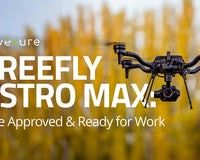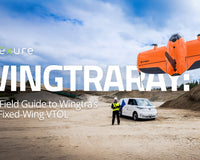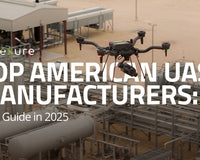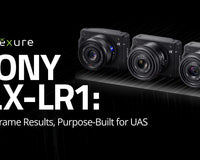Introduced in February of 2025, the all-new Freefly Astro Max is the latest evolution of Freefly Systems’ compact industrial drone line. Built and tested in Woodinville, WA, the platform inherits more than a decade of engineering lessons across earlier Freefly aircraft, while adding the regulatory assurances many U.S. programs now require. Astro Max ships with both NDAA-compliant hardware and a DIU Blue Options, giving agencies and enterprise operators a vetted option for data-sensitive work.
Beyond compliance, Astro Max brings practical upgrades: a 3 kg payload limit (60% more thrust than Astro Prime), up to 39 minutes of no-payload airtime, hot-swappable SL8 batteries, and an open smart-dovetail interface that accommodates everything from 61MP photogrammetry cameras to LiDAR scanners or multispectral sensors.
Paired with the Pilot Pro controller (available in either Doodle Labs Blue-approved or Herelink RF bundles) Astro Max is positioned as a flexible tool for mapping, agriculture, inspection, and public safety missions.
Manufactured in Woodinville, WA

Freefly Systems began in a garage in 2011 and, within five years, its Mōvi™ stabilizers and CineStar multirotors were powering a majority of high-end film and TV productions. That early focus on cinema taught the team a simple lesson: professional crews need quality tools that flex. Today, Freefly designs, machines, and assembles every airframe, gimbal, and controller at its Woodinville, Washington headquarters, running each product through in-house structural, environmental, and software tests before release.
While its hardware still carries Hollywood cameras, Freefly recognized the same engineering could tackle survey, inspection, and public-safety work. Platforms like Alta™ and Astro™ share open interface specs, letting operators bolt on new payloads without rewiring the aircraft. A
fter more than a decade—and over 100,000 commercial flights—the company’s mission remains unchanged: build the world’s most efficient professional drone and filming ecosystem, backed by U.S. manufacturing, flexible integration, and field-proven reliability.
A Brief Timeline of Freefly Astro

August 2021 — Astro (Base) ships
Freefly’s first compact industrial aircraft leaves Woodinville with a new flight-controller stack, SL8 hot-swap batteries, and support for Sony’s A7R IV mapping kit. The Base model targets survey crews who need backpack portability without giving up 61MP photogrammetry.
May 2022 — “Astro Map” kit released
Freefly packages Astro, a three-axis gimbal, and the A7R IV into a turnkey mapping bundle, then refines the workflow by adding ESRI SiteScan support in September 2022 for seamless ArcGIS uploads.
June 2023 — Thermal payload option arrives
A Workswell Wiris Pro integration brings radiometric imaging to inspection and public-safety users. Three months later, in September 2023, the Pilot Pro controller debuted, paving the way for the NDAA-compliant Astro Prime production run that followed in October.
February 2024 — Hovermap autonomy & LiDAR
Freefly partners with Emesent to certify Hovermap ST and ST-X on Astro, giving operators a plug-and-play SLAM LiDAR and GPS-denied navigation solution.
February 2025 — Astro Max launches
The newest variant increases thrust by roughly 60 percent, raises payload capacity to 3 kg, and carries both NDAA and DIU Blue credentials. Two bundle options—Doodle Labs (Blue-approved) or Herelink RF.
Key Features of Astro Max
Payload Muscle and Propulsion Headroom

Astro Max lifts 3 kg—double the capacity of the first-generation Astro—and generates about 60% more thrust than Astro Prime. That extra headroom lets crews fly heavier LiDAR scanners, dual-sensor thermal rigs, or multispectral payloads without sacrificing control. In a no payload configuration the aircraft can remain aloft for up to 39 minutes (≈28 minutes with the LR1 sensor), giving field teams a wider mission window before swapping batteries.
61-MP Sony LR1 & Upgrade Modules

Every Astro platform was designed around high-resolution mapping, and Max continues that legacy with the 61-megapixel Sony ILX-LR1 as its flagship payload. Operators who need more can add on upgrades to the LR1, such as single-sensor thermal, dual thermal, or a laser range finder module, all without changing airframes or wiring.
Smart Dovetail Ecosystem

Freefly’s Smart Dovetail mount remains the hardware key to Astro’s flexibility. The quick-release plate supplies power, Ethernet, serial, and MAVLink straight to the payload, so swapping from an LR1 to a multispectral or LiDAR sensor takes minutes with no soldering.
Blue-listed and NDAA compliant

Astro Max ships with an NDAA-compliant and DIU Blue-listed bundle option, clearing many procurement hurdles for U.S. government agencies and critical-infrastructure inspectors. Standard Remote ID is enabled at the factory and Freefly can provide an override code for waivered BVLOS operations as well. Combined with U.S. design, machining, and assembly in Washington, the compliance package provides a clear chain of custody and responsive domestic support.
Pilot Pro Controller

Max comes with Freefly’s rugged Pilot Pro ground control station, featuring dual safety kill switches, high-resolution gimbals, and an 8-inch Samsung Galaxy Tab Active5 display. Pilots can choose a bundle with the Doodle Labs Blue-approved radio for end-to-end NDAA compliance or a lower-cost Herelink RF variant when NDAA/Blue status is not required. Internal batteries hot-swap with external packs, keeping the ground station live during long field days.
Auterion Skynode, RTK, and Cloud Connectivity
An onboard Auterion Skynode mission computer gives Astro Max native RTK support and optional LTE backhaul in North America, tying flights into Auterion Mission Control and the Auterion Suite for fleet analytics, log retention, and remote firmware management.
Astro Max Technical Specifications
|
Maximum payload |
3 kg (6.6 lb) |
|
Maximum flight time |
39 min† (no payload) |
|
Typical mapping time |
28 min† with Sony ILX-LR1 |
|
Flight time at max payload |
18 min† |
|
Propellers |
21 in carbon-fiber (four) |
|
Frame footprint |
~14 in square (booms fold to half diameter) |
|
Batteries |
Two × SL8-Air, 21.6 V (6 S), 7.3 Ah, 157 Wh, 2.25 lb each |
|
Battery cycle life |
≥ 500 charge cycles |
|
Charger |
SL8 Fast Charger, 200 W, ≈ 90 min per pack |
|
Controller |
Pilot Pro (Doodle Labs Blue-approved or Herelink RF) |
|
Mission computer |
Auterion Skynode with optional LTE (U.S.) |
|
GNSS |
GNSS + optional RTK base-station integration |
|
Compliance |
NDAA-compliant hardware • DIU Blue listed • Standard Remote ID enabled |
|
Travel case |
SKB 3i-2217-10 (submersible/dust-tight) |
|
Kit weight (in case) |
36.16 lb as shipped (no batteries) • 40.66 lb with two SL8 packs |
† Flight times are manufacturer test figures at sea level in zero-wind conditions. Actual endurance will vary with altitude, temperature, and mission profile.
*SL8-Air batteries and chargers are required for flight but sold separately.
Astro Series Comparison
A side-by-side look at the three Astro variants shows how Freefly has expanded capability and compliance without losing sight of the platform’s compact form factor.
|
Feature |
Astro |
Astro Prime |
Astro Max |
|
Compliance Options |
— |
NDAA-compliant |
NDAA-compliant & DIU Blue |
|
Max payload |
2 kg |
2 kg |
3 kg |
|
Flight time — no payload* |
32 min |
37 min |
39 min |
|
Flight time — mapping payload* |
26–31 min (A7R IV) |
28–34 min (LR1) |
28 min (LR1) |
|
Controller |
Herelink RF |
Pilot Pro + Doodle RF |
Pilot Pro (Doodle RF or Herelink RF) |
|
Thrust gain vs. Base |
— |
+30 % |
+60 % |
|
Case weight, no batteries |
58.5 lb |
58.5 lb |
36.16 lb |
* Manufacturer figures at sea level, zero-wind. Endurance varies with altitude, air temp, and mission profile.
Astro Max Bundles & Pricing

Astro Max + Pilot Pro (Doodle Labs RF) — NDAA / Blue bundle
This package pairs the Astro Max airframe with Freefly’s Pilot Pro controller fitted with a Doodle Labs 2.4 GHz radio, keeping every link—from aircraft to ground station—inside DIU Blue and NDAA compliance. The travel case ships with the folded airframe, Pilot Pro, basic tools, four prop-protectors, and spare isolators; operators add SL8-Air batteries, chargers, and payloads to suit their missions. Starting price: $27,200 USD (airframe, controller, case, and tools).
Astro Max + Pilot Pro (Herelink RF) — non-NDAA bundle
For programs that don’t require Blue approval but still want U.S. manufacture and open-sensor flexibility, Freefly offers Astro Max with a Herelink 2.4 GHz radio in the same rugged case and tool kit. Starting price: $21,000 USD (airframe, controller, case, and tools). For details, visit this page to request a quote.
† Prices exclude SL8-Air batteries, SL8 fast chargers, payloads, and accessory cases. Final cost varies with sensor choice, RTK modules, and other add-ons.
Astro Max Payloads & Sensor Ecosystem
Astro Max’s Smart Dovetail mount supplies power, data, and quick-release hardware to dozens of sensors—letting crews swap from photogrammetry to LiDAR or thermal imaging in minutes.
RGB & Mapping
-
Sony ILX-LR1 (61 MP)
-
LR1 Thermal Upgrade – adds radiometric camera
-
LR1 Dual-Thermal Upgrade – wide + zoom thermal cores
-
LR1 Laser Range-Finder Upgrade – downward 905 nm LRF
-
Mapping Payload (Sony α7R IV) – 61 MP, gimbal-mounted kit
-
Sentera 65R – 65 MP global-shutter mapper
Thermal
-
Sentera 6X Thermal / Thermal Pro – multi-sensor radiometric packages
-
Workswell Wiris Pro – 640 × 512 px core with 30× optical zoom
Multispectral
-
Sentera 6X Multispectral – six-band sensor for crop analytics
LiDAR
-
Emesent Hovermap ST / ST-X – 32-channel SLAM LiDAR pods with autonomy
-
Phoenix LiDAR REcon XT – survey-grade Ouster OS1 sensor
-
Rock Robotic R3 Pro – 32-beam LiDAR with RGB fusion
-
RESEPI™ Ouster OS1-64 – 64-channel high-density mapper
Specialty
-
Ventus OGI – optical-gas-imaging thermal core
-
GreenValley X3C-H – aerial forestry 3D scanner
-
Sixarms RF Analyzer – spectrum-monitoring payload
-
Wildlife Drones RF Tracker – VHF animal-tag receiver
Freefly continuously certifies new payloads; view the full, up-to-date directory on the Freefly Astro payload page.
Industry Use Cases for Astro Max
Construction & Surveying
Astro Max combines 61-MP photogrammetry, 15 m/s precision handling, and long flights to compress field-to-finish timelines on complex, or even GPS-challenged, jobsites. A single 25-minute flight with the Sony LR1 can produce high-quality orthos for cut-and-fill analysis.
Film & Broadcasting
High power-to-weight, cinema-grade imaging, and an encrypted downlink give creative teams agile, visually striking shots without heavy-lift rigs. Astro Max’s 5m/s position-mode speed and tight control make fast chase sequences achievable in a single take, and Pilot Pro can stream stabilized LR1 footage straight to set monitors so directors get real-time feedback
Agriculture
A single airframe covers the full season’s agronomy workflow. Swap to the Sentera 6X multispectral package for NDVI layers that expose stress, irrigation gaps, or nutrient issues; then fly high-resolution RGB passes with the LR1 to perform stand counts and refine variable-rate prescriptions.
Infrastructure Inspections
Astro Max keeps technicians on the ground while uncovering faults early. Add the FLIR Boson 640 × 512 thermal upgrade to the LR1 to pinpoint hotspots in panels, transformers, or roofs without shutdowns, or rely on the 61MP sensor alone to spot hairline cracks and corrosion from a safe standoff.
Public Safety
Secure, Blue-listed hardware and rapid deployment provide responders with real-time aerial intelligence at critical incidents. The encrypted Doodle Labs link satisfies federal data-security mandates during crowd-control, fire, or tactical missions, and the LR1 thermal upgrade cuts through smoke or darkness to locate victims or hidden hotspots within minutes.
Mining & Aggregates
Astro Max’s rugged sensor options improve safety, accuracy, and compliance from pit walls to processing lines. The Emesent Hovermap ST-X can generate dense point clouds of highwalls and underground stopes while keeping surveyors clear of hazards.
Freefly Astro Max FAQ
Is the entire Astro Max system DIU Blue and NDAA compliant out of the box?
Only the bundle that ships with the Pilot Pro controller fitted with the Doodle Labs RF radio is fully DIU Blue listed and NDAA compliant from airframe to ground link.
What is the maximum payload the Astro Max can lift, and how does that affect flight time?
Astro Max is rated for a 3 kg (6.6 lb) payload. With that full load it flies about 18 minutes; with the standard Sony ILX-LR1 mapping payload it averages ≈ 28 minutes; with no payload it can reach ≈ 39 minutes (manufacturer zero-wind figures).
Do the listed starting prices include batteries and chargers?
No. SL8-Air batteries (two required per flight), SL8 Fast Chargers, and any payloads or RTK bases are purchased à la carte so customers can tailor the kit to their mission and budget.
Can I use RTK or PPK workflows with Astro Max?
Yes. The onboard Auterion Skynode supports RTK through a user-supplied ground-station computer and GNSS base. PPK workflows are also possible by exporting log files from Auterion Suite and processing them with your preferred software.
Which sensors are officially supported today?
Freefly certifies new payloads continuously, but headline options include the Sony ILX-LR1 (with thermal and laser-range-finder upgrades), Sentera 65R and 6X series, Workswell Wiris Pro, Emesent Hovermap ST / ST-X, Phoenix LiDAR REcon XT, Rock Robotic R3 Pro, and more listed on Freefly’s payload directory.
How long does it take to swap payloads in the field?
Most sensors mount to the Smart Dovetail with a single latch and shared power/data connector. Experienced crews typically change from one payload to another in under two minutes without tools.
What kind of after-sales support is available?
Freefly provides U.S.-based phone and email support, stocks spare parts in Washington, and publishes detailed wiki documentation for self-service maintenance. Firmware updates and flight-log management run through Auterion Suite, included with every Astro Max.
Final Takeaways
Astro Max elevates the compact Astro line into a 3 kg-lift, Blue-listed workhorse that can switch from 61MP photogrammetry to thermal or LiDAR in minutes and cruise for around 20 min. With its rugged Pilot Pro controller, open Smart Dovetail integrations, and U.S. manufacturing, Astro Max offers one scalable solution for mapping, inspection, public safety, and beyond.
Ready to explore configurations and pricing? Learn more here.










